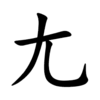尢
| ||||||||
| ||||||||
| ||||||||
 | ||||||||
| ||||||||
Translingual
| Stroke order | |||
|---|---|---|---|
 | |||
Han character
尢 (Kangxi radical 43, 尢+0, 3 strokes, cangjie input 大山 (KU) or 難大山 (XKU), four-corner 40010, composition ⿸𠂇乚)
- Kangxi radical #43, ⼪.
Descendants
References
- Kangxi Dictionary: page 298, character 2
- Dai Kanwa Jiten: character 7539
- Dae Jaweon: page 593, character 1
- Hanyu Da Zidian (first edition): volume 1, page 551, character 10
- Unihan data for U+5C22
- Unihan data for U+2F875
Chinese
Glyph origin
| Historical forms of the character 尢 | |||
|---|---|---|---|
| Shang | Western Zhou | Shuowen Jiezi (compiled in Han) | |
| Oracle bone script | Bronze inscriptions | Ancient script | Small seal script |
 |
 |
 |
 |
Ideogram (指事) , a man with bent legs (jumping or collapsing). Compare with 大, which derives from a man with straight legs, and in present form has slightly different strokes.
Pronunciation
See also
- 尪 (wāng)
Japanese
Kanji
尢
- This term needs a translation to English. Please help out and add a translation, then remove the text
{{rfdef}}.
Vietnamese
Han character
尢: Hán Nôm readings: uông, vưu
- This term needs a translation to English. Please help out and add a translation, then remove the text
{{rfdef}}.
This article is issued from Wiktionary. The text is licensed under Creative Commons - Attribution - Sharealike. Additional terms may apply for the media files.